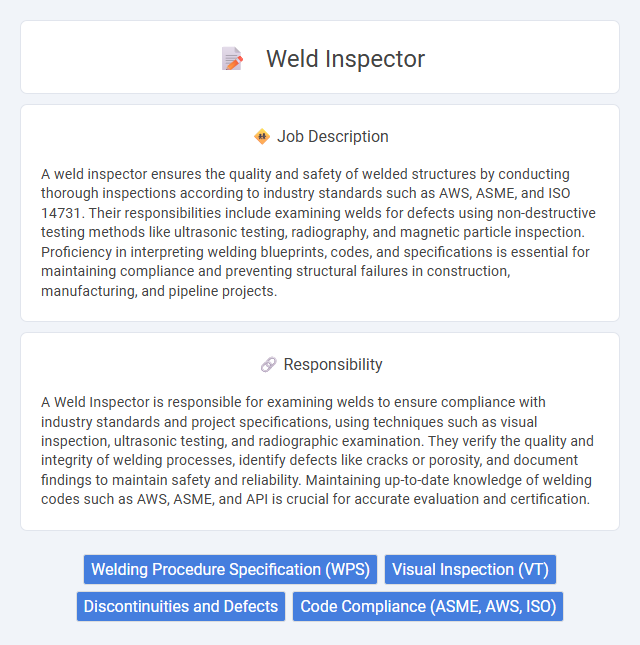
A weld inspector ensures the quality and safety of welded structures by conducting thorough inspections according to industry standards such as AWS, ASME, and ISO 14731. Their responsibilities include examining welds for defects using non-destructive testing methods like ultrasonic testing, radiography, and magnetic particle inspection. Proficiency in interpreting welding blueprints, codes, and specifications is essential for maintaining compliance and preventing structural failures in construction, manufacturing, and pipeline projects.
Individuals with strong attention to detail and good visual acuity are likely to be well-suited for a weld inspector role, as the job requires careful examination of welds to ensure quality and safety standards. Those who can handle repetitive tasks and possess knowledge of welding processes and materials probably have a higher chance of success in this position. Physical stamina may be necessary since the job can involve inspecting welds in various environments, which suggests candidates with good physical health might be more suitable.
Qualification
A Weld Inspector must possess certifications such as AWS Certified Weld Inspector (CWI) or equivalent qualifications recognized by industry standards like ASNT or ISO 9712. Strong knowledge of welding processes, metallurgy, and non-destructive testing (NDT) methods including ultrasonic testing (UT), radiographic testing (RT), and magnetic particle testing (MT) is essential. Experience in interpreting welding codes and standards such as API 1104, ASME Section IX, and AWS D1.1 is crucial for ensuring quality control and compliance on construction or manufacturing projects.
Responsibility
A Weld Inspector is responsible for examining welds to ensure compliance with industry standards and project specifications, using techniques such as visual inspection, ultrasonic testing, and radiographic examination. They verify the quality and integrity of welding processes, identify defects like cracks or porosity, and document findings to maintain safety and reliability. Maintaining up-to-date knowledge of welding codes such as AWS, ASME, and API is crucial for accurate evaluation and certification.
Benefit
A weld inspector job likely offers benefits such as competitive salaries and opportunities for career advancement due to the critical role in ensuring structural integrity and safety. Access to specialized training and certifications may be probable, enhancing professional credibility and skillset. Health insurance and retirement plans could also be common perks, reflecting the importance of maintaining workforce well-being.
Challenge
Weld inspector jobs likely involve significant challenges due to the need for precise assessment of weld quality under strict industry standards. The role probably requires balancing technical knowledge with meticulous attention to detail to identify defects that could compromise structural integrity. Challenges might also include working in variable environments and ensuring compliance with safety regulations while managing tight project deadlines.
Career Advancement
Weld inspectors play a critical role in ensuring weld quality and safety in industries such as construction, manufacturing, and oil and gas. Career advancement opportunities include specialization in non-destructive testing methods, obtaining certifications like AWS CWI or CSWIP, and progressing to supervisory or quality assurance management roles. Strong knowledge of welding codes and standards, along with experience in inspection technologies, significantly enhances a weld inspector's path toward higher responsibility and salary growth.
Key Terms
Welding Procedure Specification (WPS)
A Weld Inspector ensures compliance with Welding Procedure Specifications (WPS) by verifying that welding activities conform to pre-approved technical requirements and standards such as AWS and ASME. They meticulously review welding parameters, materials, and techniques outlined in the WPS to maintain structural integrity and safety. Proficiency in interpreting WPS documentation and performing inspections using non-destructive testing methods is critical for quality control in fabrication and construction projects.
Visual Inspection (VT)
Weld inspectors specializing in Visual Inspection (VT) meticulously examine welds for surface defects, ensuring compliance with industry standards such as AWS D1.1 and ASME Section IX. They utilize tools like magnifying glasses, weld gauges, and bleeders to detect cracks, porosity, and undercuts, crucial for maintaining structural integrity. Proficiency in recognizing weld discontinuities and proper documentation supports quality assurance and safety in construction and manufacturing projects.
Discontinuities and Defects
Weld inspectors specialize in identifying discontinuities such as cracks, porosity, undercuts, and incomplete fusion that compromise weld integrity. Utilizing non-destructive testing methods like ultrasonic testing, radiography, and dye penetrant inspection, they ensure welds meet stringent industry standards and codes. Early detection of defects prevents structural failures and extends the lifespan of welded components across various industries including oil and gas, construction, and manufacturing.
Code Compliance (ASME, AWS, ISO)
Weld inspectors ensure code compliance by rigorously evaluating welding procedures against ASME, AWS, and ISO standards to maintain structural integrity and safety. They perform detailed visual inspections, nondestructive testing, and document findings to verify that welds meet specified quality criteria. Proficiency in interpreting code requirements and specifications is critical for identifying defects and ensuring adherence to industry regulations.
 kuljobs.com
kuljobs.com